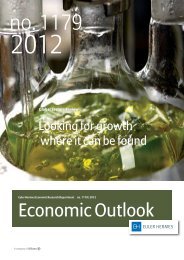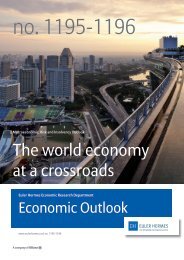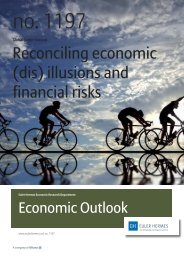Create successful ePaper yourself
Turn your PDF publications into a flip-book with our unique Google optimized e-Paper software.
<strong>Euler</strong> <strong>Hermes</strong><br />
Economic Outlook no. 6 | 2011 - Global Sectors Review<br />
Indicators<br />
Grains<br />
Petroleum<br />
Sustainable easing or only a pause?<br />
Late June brought surprising USDA corn figures, with higher<br />
than expected planting figures for spring and lower than<br />
expected reductions (although still to low levels ) in stocks.<br />
These <strong>en</strong>couraging prospects for the world's biggest corn<br />
producer also accelerated the decline in Chicago prices,<br />
initiated by the contraction in domestic demand (-15.7% yr/yr<br />
over March-May 2011). The sharp price fluctuations se<strong>en</strong><br />
rec<strong>en</strong>tly could also reflect the scale of arbitraging by purely<br />
financial investors. Nevertheless, world supply and demand<br />
t<strong>en</strong>sions – which spurred the market to record highs in early<br />
June – still largely persist and point to continued firm prices.<br />
Moreover, beyond the probable revisions to USDA figures,<br />
major uncertainties over yields persist (poor weather<br />
conditions during planting) and over ethanol production<br />
requirem<strong>en</strong>ts. For wheat, despite more sustainable<br />
fundam<strong>en</strong>tals and the announcem<strong>en</strong>t of the lifting of Russian<br />
export restrictions, price tr<strong>en</strong>ds will inexorably correlate with<br />
the fate of corn prices, giv<strong>en</strong> its status as an alternative<br />
feedgrain in animal husbandry. Climatic ev<strong>en</strong>ts in China and<br />
Europe are also likely to impact on coming harvests. _BG<br />
Down in the short term, up in the long term<br />
Towards the <strong>en</strong>d of 2010, the uprisings in the Middle East that<br />
spread to become the ‘Arab Spring’ of 2011, and that cut<br />
nearly 2% of crude oil production from the world market,<br />
height<strong>en</strong>ed fears of supply disruptions and probably increased<br />
speculation. This combination of factors led to oil prices<br />
rising by 35% from February to April. But the slowing of the<br />
economy, the uncertainties raised by the problems of US and<br />
European debt, and the probable withdrawal of speculators<br />
from the market s<strong>en</strong>t prices back down by 15%. At around<br />
$110/bbl, however, Br<strong>en</strong>t crude was still thought to be too<br />
high by some. Saudi Arabia also attempted to keep prices low<br />
to prev<strong>en</strong>t the fragile OECD economies from further decline.<br />
At June’s OPEC meeting, the Kingdom advocated higher production<br />
ceilings to lower prices, but an Iran-led conting<strong>en</strong>t<br />
opposed the Saudis, and the price later steadied at around<br />
$110/bbl. In the short term, the slowing in world growth<br />
should impact on prices, but in the longer term, the extraordinary<br />
growth in the requirem<strong>en</strong>ts of China and other emerging<br />
countries have every chance of sparking another surge<br />
in oil prices._DN<br />
World grains production<br />
Millions of tonnes<br />
900,000 Corn<br />
Wheat<br />
800,000<br />
Petroleum prices<br />
USD per barrel<br />
160<br />
140<br />
120<br />
100<br />
700,000<br />
80<br />
60<br />
600,000<br />
40<br />
20<br />
500,000<br />
05/06 06/07<br />
Sources: Cyclope/USDA<br />
07/08<br />
08/09<br />
09/10<br />
10/11 11/12p<br />
0<br />
00 01 02 03 04 05 06<br />
Source: New York Mercantile Exchange<br />
07<br />
08<br />
09<br />
10<br />
11<br />
6












